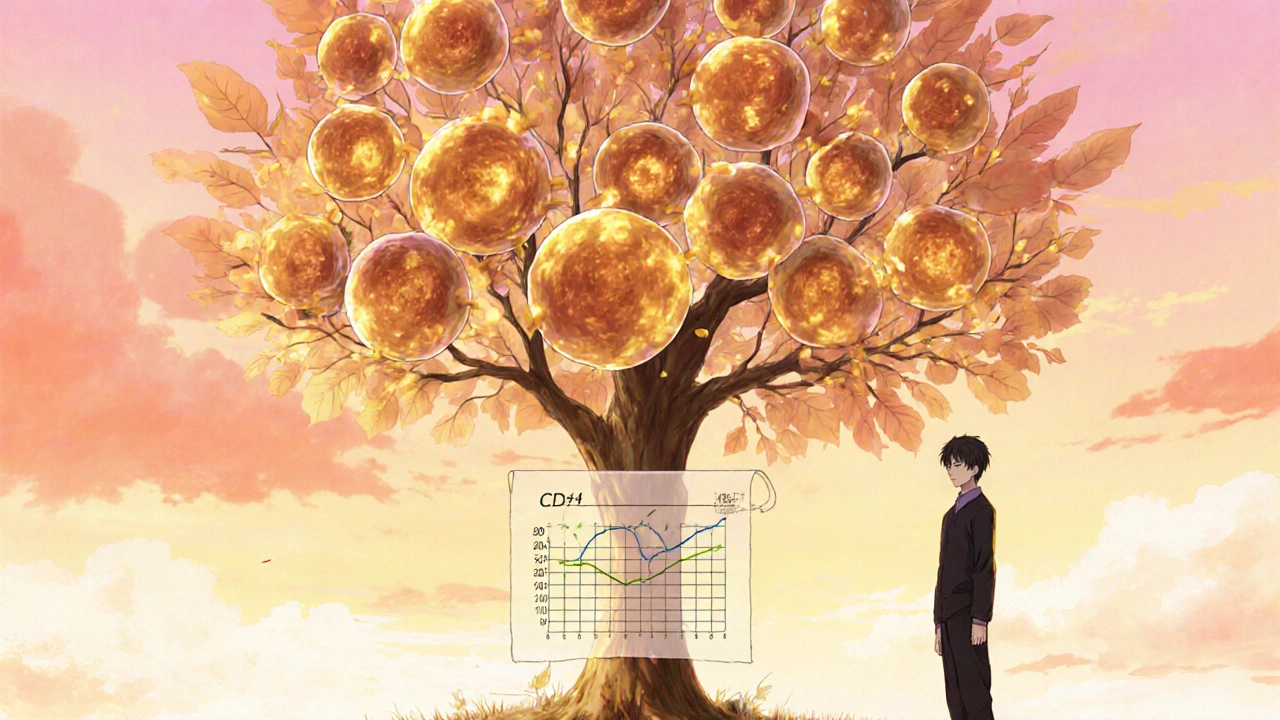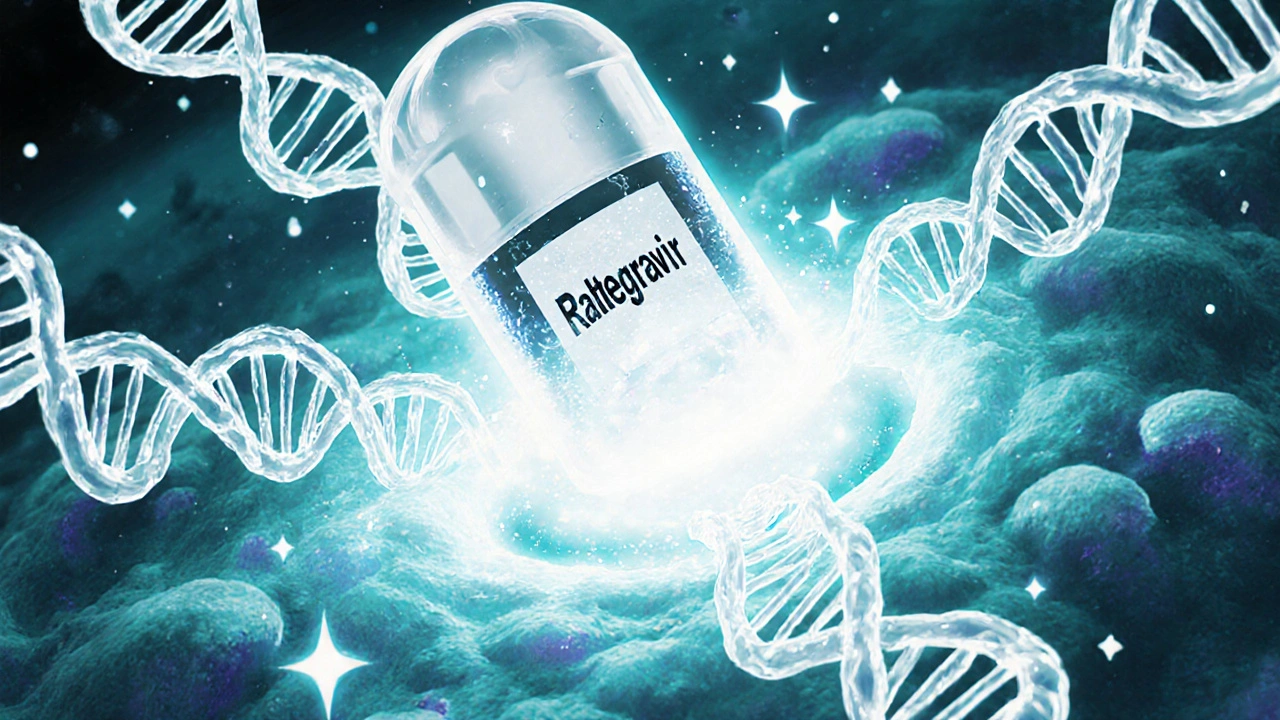CD4 Recovery Estimator
Estimate how your CD4 count might improve after starting antiretroviral therapy. Based on clinical studies showing raltegravir's impact on immune recovery.
Your Projected CD4 Count
Based on 48-week clinical data
Immune Recovery Progress
Why Raltegravir Matters
- Rapid viral suppression - Often reaches undetectable viral load in 2 weeks
- Reduced inflammation - Lowers markers like IL-6 and D-dimer
- Higher CD4 gains - Up to 30-50 cells/µL more than some alternatives
When you hear the word raltegravir, you might picture another pill in a long‑term HIV regimen. But what most patients don’t realize is how this drug can shape the way their immune system bounces back after starting therapy. Below we break down what raltegravir does, why immune reconstitution matters, and how the two connect for everyday patients.
Key Takeaways
- Raltegravir is an integrase inhibitor that blocks HIV from inserting its DNA into your cells.
- Immune reconstitution refers to the rise in CD4+ T‑cell counts and the restoration of immune function after starting antiretroviral therapy (ART).
- Clinical studies show raltegravir can speed up CD4 recovery, especially in patients with very low baseline counts.
- Side‑effects are generally mild, but adherence is crucial for maintaining both viral suppression and immune health.
- Regular monitoring of viral load and CD4 counts lets you and your clinician spot any issues early.
What is raltegravir?
Raltegravir is a first‑generation integrase strand transfer inhibitor (INSTI) used in combination antiretroviral therapy to halt HIV replication. Approved in 2007, it works by blocking the viral enzyme integrase, which is needed for HIV DNA to lock into the host’s genome. Without that step, the virus can’t multiply effectively.
Raltegravir is taken twice daily (normally 400 mg each dose) and can be paired with a variety of nucleoside reverse transcriptase inhibitors (NRTIs) like tenofovir/emtricitabine. Because it targets a different part of the virus than older drugs, resistance to raltegravir tends to develop slower, making it a solid backbone for many treatment plans.
What is immune reconstitution?
Immune reconstitution is the process by which a person’s immune system recovers after starting effective antiretroviral therapy. The hallmark sign is an increase in CD4+ T cells, the white blood cells that coordinate immune responses.
Before therapy, HIV attacks and depletes CD4+ cells, leaving the body vulnerable to infections and cancers. Once viral replication drops (usually measured as viral load below 50 copies/mL), the bone marrow and lymphoid tissues can start producing new CD4+ cells, and the immune system slowly regains strength. The speed and extent of this recovery affect everything from everyday stamina to the risk of opportunistic infections.

How raltegravir supports immune recovery
Because raltegravir brings viral load down quickly-often within two weeks of starting therapy-it removes the main roadblock to CD4+ cell regeneration. Faster viral suppression means the immune system spends less energy fighting active virus and more time rebuilding.
Several mechanisms tie raltegravir to better immune outcomes:
- Rapid decline in viral load: Early studies showed a median drop of 1.5 log copies/mL by week 4, outpacing many older protease inhibitors.
- Reduced immune activation: High viral activity triggers chronic inflammation. By silencing the virus early, raltegravir lowers inflammatory markers like IL‑6 and D‑dimer, which are linked to slower CD4 recovery.
- Lower metabolic burden: Unlike some drugs that cause lipodystrophy, raltegravir has a minimal impact on cholesterol and triglycerides, allowing the body to allocate resources toward immune cell production.
For patients who start treatment with a CD4 count below 200 cells/µL, these advantages can translate into an extra 30-50 cells/µL gain in the first six months compared with certain older regimens.
Clinical evidence and numbers
Real‑world data from the ACTG (AIDS Clinical Trials Group) and European cohorts give a clear picture:
- In a 2019 ACTG analysis of 1,200 treatment‑naïve adults, those on raltegravir‑based ART achieved mean CD4 gains of 115 cells/µL at 48 weeks, versus 95 cells/µL for a boosted protease inhibitor group.
- Patients with baseline CD4 < 100 cells/µL showed a median increase of 80 cells/µL at 24 weeks on raltegravir, compared to 55 cells/µL with efavirenz.
- Long‑term follow‑up (5 years) indicates that about 85 % of raltegravir users maintain viral suppression < 50 copies/mL, and 70 % reach CD4 counts above 350 cells/µL.
These numbers matter because reaching a CD4 count of 350-500 cells/µL is often the threshold where patients notice fewer infections, regain weight, and feel less fatigued.

Comparing raltegravir with other integrase inhibitors
| Drug | Typical Dose | Time to viral load < 50 copies/mL | Average CD4 gain (48 weeks) | Common side‑effects |
|---|---|---|---|---|
| Raltegravir | 400 mg BID | 2 weeks | +115 cells/µL | Headache, mild nausea |
| Dolutegravir | 50 mg QD | 1 week | +120 cells/µL | Insomnia, weight gain |
| Elvitegravir (boosted) | 150 mg QD + cobicistat | 2 weeks | +105 cells/µL | Elevated creatinine, GI upset |
All three drugs achieve rapid viral suppression, but dolutegravir often shows the fastest time to undetectable viral load. Raltegravir’s advantage is its low drug‑interaction profile, making it a go‑to for patients on other meds (e.g., epilepsy or TB treatment).
Practical tips for patients on raltegravir
Knowing the science helps, but day‑to‑day habits keep the benefits coming.
1. Stick to the schedule
Raltegravir is taken twice a day, usually 12 hours apart. Missing a dose can let the virus rebound enough to stall CD4 recovery. Set alarms, link the pill to a daily routine (like brushing teeth), or use a pill‑box with compartments for morning and night.
2. Watch for side‑effects
Most people experience mild headache or nausea that fades after a few weeks. If you get persistent rash, severe stomach pain, or unusual fatigue, contact your clinician-these could signal rare reactions or a drug interaction.
3. Keep lab appointments
Baseline labs should include CD4 count, viral load, liver function, and kidney function. Follow‑up labs are usually at weeks 4, 12, and then every 3‑6 months. Seeing a steady rise in CD4 and an undetectable viral load confirms the immune system is on track.
4. Discuss other meds
Because raltegravir doesn’t use the cytochrome P450 pathway, it plays well with many other drugs. Still, always list every prescription, over‑the‑counter product, and supplement to your HIV specialist.
5. Lifestyle matters
Good nutrition, regular exercise, and adequate sleep magnify the immune benefits. Even modest activities-like brisk walking three times a week-can improve CD4 recovery rates according to a 2022 cohort study.
Frequently Asked Questions
Can raltegravir be started right after an HIV diagnosis?
Yes. Guidelines from WHO and DHHS recommend initiating an integrase‑inhibitor‑based regimen, like raltegravir, as soon as possible after diagnosis to limit immune damage and start the reconstitution process early.
How long does it take to see CD4 count improvement?
Most patients notice a rise of 30-50 cells/µL within the first three months if viral load becomes undetectable. Larger gains continue over the first year, especially when baseline CD4 is very low.
Is raltegravir safe for pregnant women?
Current data suggest raltegravir is safe in pregnancy, and many clinicians use it during the third trimester to maintain viral suppression and protect the infant’s immune system.
What should I do if I miss a dose?
Take the missed dose as soon as you remember, unless it’s almost time for the next dose. In that case, skip the missed one and continue with the regular schedule. Avoid taking two doses close together.
Can I switch from another INSTI to raltegravir?
Switching is possible, but you need a clinician’s guidance to manage timing and avoid gaps in viral suppression. Often a simple switch is done on the same day if both drugs are part of a fixed‑dose combination.
Understanding how raltegravir fits into the bigger picture of immune recovery equips you to ask the right questions at appointments and stay motivated during the early weeks of treatment.


Thank you for sharing this comprehensive overview of raltegravir and its role in immune reconstitution. The explanation of how rapid viral suppression facilitates CD4 recovery is clear and evidence‑based. It is especially helpful that you highlighted the comparative data with other INSTIs, which assists clinicians in individualized regimen selection. Patients will appreciate the practical tips regarding adherence and coordination with other medications. Overall, this article serves as an inclusive guide for both providers and those living with HIV.
Wow, this piece really brings the science to life! I love how you break down the numbers and then tie them to everyday experiences for patients. The dramatic impact of a 30‑50 cell boost in the first months can be a game‑changer for someone fighting low CD4 counts. Keep the optimism flowing, because every extra CD4 cell is a step toward feeling normal again!
Many readers fail to see that the swift decline in viral load achieved by raltegravir is not merely a pharmacological coincidence but part of a larger agenda orchestrated by powerful pharmaceutical conglomerates that profit from perpetual dependence on medication supplies. The rapid suppression creates an illusion of immune recovery while the underlying inflammatory pathways remain subtly disturbed by unseen adjuvants embedded in the drug formulation. Consequently patients experience a modest rise in CD4 counts that masks the continued activation of the innate immune system which, according to independent analyses, correlates with long‑term cardiovascular risk. Moreover the comparative tables presented in the article conveniently omit the cost differential that places raltegravir beyond the reach of many national health services, thereby reinforcing a market that favors higher‑priced alternatives. It is also worth noting that the cited studies frequently rely on surrogate endpoints such as laboratory CD4 numbers rather than hard clinical outcomes like morbidity reduction, a fact that is brushed aside by proponents eager to tout favorable statistics. The claim that raltegravir has a minimal metabolic burden ignores the subtle lipidomic shifts observed in metabolomics profiling, which are not captured in routine lipid panels but have been linked to endothelial dysfunction. Patients are urged to adhere strictly to the twice‑daily schedule, yet the article does not address the real‑world challenges of maintaining such a regimen in populations with limited access to healthcare infrastructure. The emphasis on low drug‑interaction profile is also a double‑edged sword because it invites clinicians to combine raltegravir with untested complementary therapies that may undermine its efficacy. In addition the narrative suggests that immune reconstitution is a linear process, whereas longitudinal data reveal a stochastic pattern with frequent plateaus and occasional declines that are rarely discussed. The author’s omission of potential resistance pathways emerging under selective pressure further underscores a bias towards presenting a uniformly positive picture. Finally the recommendation to monitor labs at weeks 4 and 12 aligns conveniently with standard appointment schedules that benefit clinic revenue streams rather than patient convenience. While the article is well written, a critical reader must remain aware of the underlying motivations that shape the presentation of data. In sum, the benefits of raltegravir are real but must be weighed against hidden costs, subtle adverse effects, and the broader socioeconomic context that the piece largely overlooks. Therefore clinicians should consider alternative regimens with more transparent data when available. A balanced assessment will ultimately serve the patient’s long‑term health better than a one‑sided endorsement.
Reading through the data, one cannot ignore the subtle hierarchy that emerges between the integrase inhibitors. While raltegravir offers a respectable CD4 gain, the narrative tends to elevate it without fully acknowledging the superior time to suppression observed with dolutegravir. The balanced perspective would highlight that the choice of regimen should be guided by individual comorbidities, not merely by drug‑interaction profiles. Nevertheless the article succeeds in presenting the essential practical advice in an accessible manner. It serves as a useful reference for patients navigating their treatment options.
great info but i wish there were more tips on diet.
Raltegravir’s rapid viral suppression ties directly into CD4 recovery in a way that feels almost inevitable. The mechanistic link is simple yet profound; reduce virus and the immune system can rebuild. Observing the data, one notes the consistency across multiple cohorts. The pragmatic guidance on adherence resonates with everyday life. In philosophical terms the drug acts as a catalyst for the body’s self‑healing narrative.
The data clearly show that early initiation of raltegravir accelerates CD4 restoration and that patients should be proactive about their lab follow‑ups. It is essential to set alarms and link medication intake to daily routines to avoid missed doses. Side‑effects are generally mild but any persistent symptom deserves prompt medical attention. A supportive community can reinforce adherence and improve overall outcomes. Stay confident and keep advocating for your health.
Fantastic breakdown! The side‑effect profile of raltegravir is reassuring, especially for those worried about weight gain. Pairing the medication with a balanced diet and regular walks can boost those CD4 numbers even more. Keep spreading this positive, actionable information!
One must appreciate the nuanced elegance of raltegravir’s pharmacodynamics as presented in this discourse. It serves not merely as a virologic suppressor but as a subtle orchestrator of immune equilibrium. The author’s inclusion of comparative tables enriches the reader’s comprehension, albeit with a casual flair. While the tone remains friendly, the underlying intellectual rigor remains evident. Such a presentation bridges the gap between clinical precision and accessible narrative.
The article adeptly synthesizes virological kinetics with immunological reconstitution metrics, yet it conspicuously sidesteps a deep dive into the pharmacogenomic variability that can modulate raltegravir efficacy. From a mechanistic standpoint, the integrase inhibition paradigm is robust, but clinicians must also consider CYP substrate polymorphisms that, while peripheral, introduce a layer of complexity often overlooked in mainstream discourse. Moreover, the cost‑effectiveness analysis is superficially addressed, neglecting the nuanced health economics models that factor in quality‑adjusted life years. In contraposition to the prevailing optimistic narrative, one must remain vigilant about emerging resistance mutations that could compromise long‑term outcomes. Consequently, the discourse would benefit from integrating a multidimensional risk‑benefit framework rather than a unidimensional efficacy focus.
The dramatic resurgence of CD4 counts under raltegravir is nothing short of a renaissance for the immune system. Yet one must not be blinded by the allure of rapid viral decline without scrutinizing the subtle immunological trade‑offs. The narrative drifts toward melodrama while omitting the quiet specter of long‑term inflammation. In truth, a balanced appraisal demands acknowledgment of both the triumphs and the lingering uncertainties.